change time OLDSMOBILE SILHOUETTE 1998 User Guide
[x] Cancel search | Manufacturer: OLDSMOBILE, Model Year: 1998, Model line: SILHOUETTE, Model: OLDSMOBILE SILHOUETTE 1998Pages: 444, PDF Size: 23.2 MB
Page 264 of 444

/I CAL TION:
Things you put inside your vehicle can strike
and injure people in a sudden stop or turn, or in
a crash.
0 Put things in the cargo area of your vehicle.
Try to spread the weight evenly.
0 Never stack heavier things, like suitcases,
inside the vehicle
so that some of them are
above the tops
of the seats.
0 Don’t leave an unsecured child restraint in
your vehicle.
0 When you carry something inside the
vehicle, secure it whenever you can.
0 Don’t leave a seat folded down unless you
need to.
Electronic Level Control (Option)
On vehicles equipped with the optional electronic level
control, the rear of the vehicle is automatically kept
level as you load or unload your vehicle. However, you
should still not exceed the
GVWR or the GAWR.
You may hear the compressor operating when you load
or unload your vehicle, and periodically as the system
self-adjusts. This is normal.
The compressor should operate for brief periods
of time.
If the sound continues for an extended period of time,
your vehicle needs service.
To keep your battery from
being drained, you may want to remove the
ELC fuse in
the fuse control panel until you can have your vehicle
serviced (see “Fuses and Circuit Breakers” in the Index.)
Using heavier suspension components to get added
durability might not change your weight ratings. Ask
your retailer to help you load your vehicle the right way.
4-32
ProCarManuals.com
Page 265 of 444
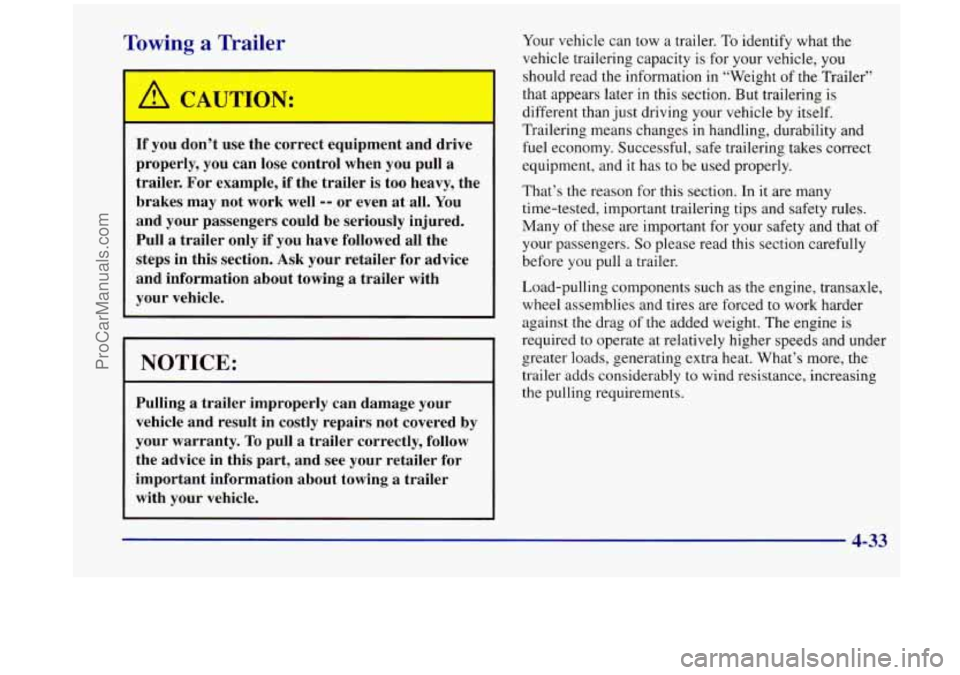
Towing a Trailer
If you don’t use the correct equipment and drive
properly, you can lose control when
you pull a
trailer. For example, if the trailer is too heavy, the
brakes may not work well
-- or even at all. You
and your passengers could be seriously injured.
Pull
a trailer only if you have followed all the
steps in this section.
Ask your retailer for advice
and information about towing a trailer with
your vehicle.
NOTICE:
Pulling a trailer improperly can damage your
vehicle and result in costly repairs not covered by
your warranty.
To pull a trailer correctly, follow
the advice in this part, and
see your retailer for
important information about towing
a trailer
with your vehicle. Your
vehicle can tow a trailer. To identify what the
vehicle trailering capacity is for your vehicle, you
should read the information in “Weight of the Trailer”
that appears later
in this section. But trailering is
different than just driving your vehicle by itself.
Trailering means changes in handling, durability
and
fuel economy. Successful, safe trailering takes correct
equipment, and it has to be used properly.
That’s the reason for this section. In it are many
time-tested, important trailering tips and safety rules.
Many of these are important for your safety and that of
your passengers.
So please read this section carefully
before you pull a trailer.
Load-pulling components such as the engine, transaxle,
wheel assemblies and tires are forced to work harder
against the drag
of the added weight. The engine is
required to operate at relatively higher speeds and under
greater loads, generating extra heat. What’s more, the
trailer adds considerably
to wind resistance, increasing
the pulling requirements.
4-33
ProCarManuals.com
Page 305 of 444
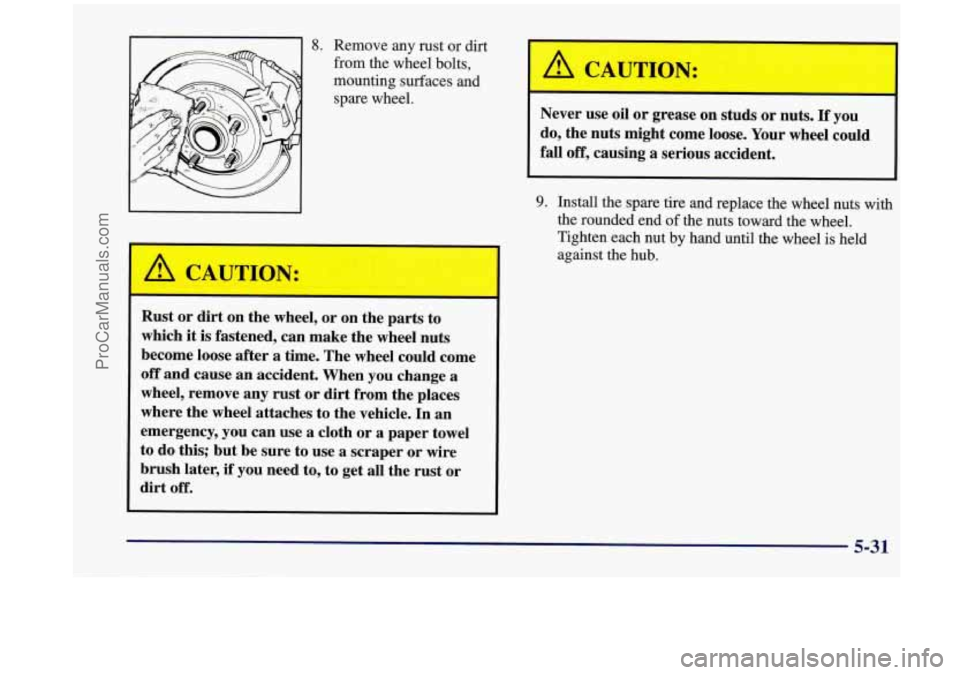
8. Remove any rust or dirt
from the wheel bolts,
mounting surfaces and
spare wheel.
Rust or dirt on the wheel, or on the parts to
which
it is fastened, can make the wheel nuts
become loose after a time. The wheel could come
off and cause an accident. When you change
a
wheel, remove any rust or dirt from the places
where the wheel attaches to the vehicle. In an
emergency, you can use a cloth or
a paper towel
to
do this; but be sure to use a scraper or wire
brush later,
if you need to, to get all the rust or
dirt off.
1 A CAUTION:
I-
Never use oil or grease on studs or nuts. If you
do, the nuts might come loose. Your wheel could
fall
off, causing a serious accident.
9. Install the spare tire and replace the wheel nuts with
the rounded end
of the nuts toward the wheel.
Tighten each nut by hand until the wheel is held
against the hub.
5-31
ProCarManuals.com
Page 328 of 444

5. Close the inner access door, while squeezing the tab,
6. Snap the outer access panel into the back of the
to be sure it is
tightly closed.
glove box.
Automatic Transaxle Fluid
r--- In to Check and Change
A good time to check your automatic transaxle fluid
level is when the engine oil is changed.
Change both
the fluid and filter every 50,000 miles
(83 000 km) if the vehicle is mainly driven under one
or more of these conditions:
0 In heavy city traffic where the outside temperature
regularly reaches
90°F (32°C) or higher.
In hilly or mountainous terrain.
0 When doing frequent trailer towing.
0 Uses such as found in taxi, police or delivery service.
If you do not use your vehicle under any
of these
conditions, the fluid and filter do not require changing.
See “Scheduled Maintenance Services” in the Index.
How to Check
Because this operation can be a little difficult, you may
choose to have this done at your Oldsmobile retail
facility Service Department.
If you do it yourself, be sure to follow all the
instructions here, or
you could get a false reading
on the dipstick.
NOTICE:
Too much or too little fluid can damage your
transaxle.
Too much can mean that some of the
fluid could come out and fall on hot engine parts
or exhaust system parts, starting a fire. Be sure to
get an accurate reading if you check your
transaxle fluid.
6-18
ProCarManuals.com
Page 340 of 444
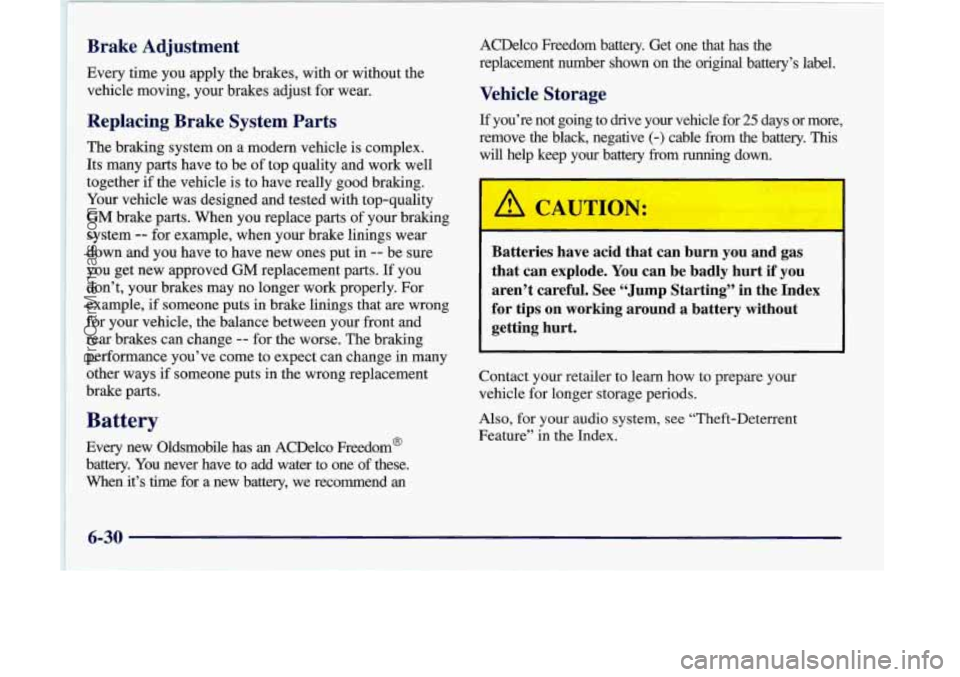
Brake Adjustment
Every time you apply the brakes, with or without the
vehicle moving, your brakes adjust for wear.
Replacing Brake System Parts
The braking system on a modern vehicle is complex.
Its many parts have to be of top quality and work well
together if the vehicle is to have really good braking.
Your vehicle was designed and tested with top-quality
GM brake parts. When you replace parts
of your braking
system
-- for example, when your brake linings wear
down and you have to have new ones put
in -- be sure
you get new approved GM replacement parts. If you
don’t, your brakes may no longer work properly. For
example,
if someone puts in brake linings that are wrong
for your vehicle, the balance between your front and
rear brakes can change
-- for the worse. The braking
performance you’ve come to expect can change in many
other ways
if someone puts in the wrong replacement
brake parts.
Battery
Every new Oldsmobile has an ACDelco Freedom@
battery. You never have to add water to one of these.
When it’s time for a new battery, we recommend
an
ACDelco Freedom battery. Get one that has the
replacement number shown on the
original battery’s label.
Vehicle Storage
If you’re not going to drive your vehicle for 25 days or more,
remove the black, negative
(-) cable from the battery. This
will help keep your battery from running down.
Batteries have acid that can burn you and gas
that can explode. You can be badly hurt if you
aren’t careful. See “Jump Starting’’ in the Index
for tips on working around a battery without
getting hurt.
Contact your retailer to learn how to prepare your
vehicle for longer storage periods.
Also, for your audio system, see “Theft-Deterrent
Fedwe’’ in the Index.
6-30
ProCarManuals.com
Page 351 of 444
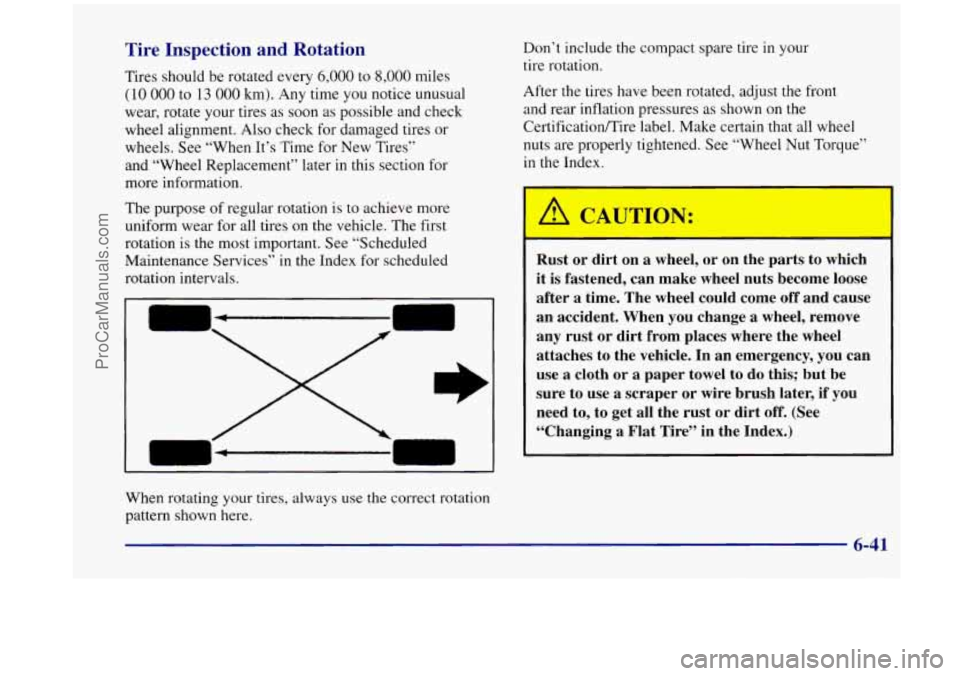
Tire Inspection and Rotation
Tires should be rotated every 6,000 to 8,000 miles
(10 000 to 13 000 km). Any time you notice unusual
wear, rotate your tires as soon
as possible and check
wheel alignment. Also crheck for damaged tires or
wheels.
See “When It’s ‘Time for New Tires”
and “Wheel Replacement” later in this section for
more information.
The purpose of regular rotation is to achieve more
uniform wear for all tires on the vehicle. The first
rotation
is the most important. See “Scheduled
Maintenance Services” in the Index for scheduled
rotation intervals.
1
When rotating your tires, always use the correct rotation
pattern shown here. Don’t
include the compact spare tire
in your
tire rotation.
After the tires have been rotated, adjust the front
and rear inflation pressures as shown on the
CertificatiodTire label. Make certain that all wheel
nuts are properly tightened. See “Wheel Nut Torque”
in the Index.
Rust or dirt on
a wheel, or on the parts to which
it is fastened, can make wheel nuts become loose
after
a time. The wheel could come off and cause
an accident. When you change
a wheel, remove
any rust or dirt from places where the wheel
attaches to the vehicle. In an emergency, you can
use
a cloth or a paper towel to do this; but be
sure
to use a scraper or wire brush later, if you
need to,
to get all the rust or dirt off. (See
“Changing
a Flat Tire” in the Index.)
6-41
ProCarManuals.com
Page 425 of 444
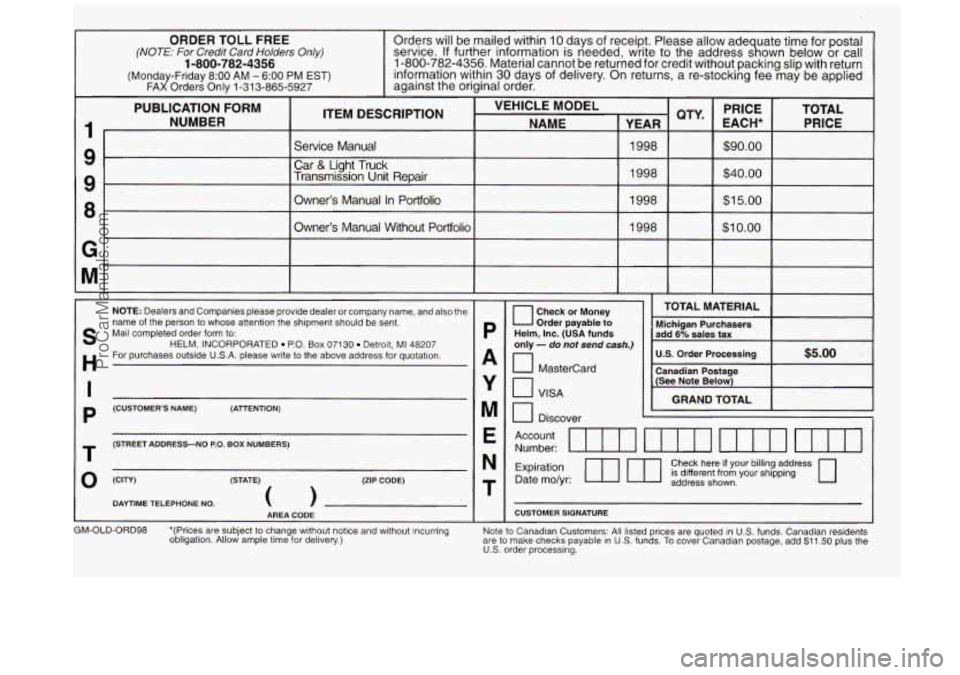
ORDER TOLL FREE (NOTE: For Credif Card Holders Only)
(Monday-Friday 8:OO AM - 6:OO PM EST) FAX Orders Only 1-31 3-865-5927
1-800-782-4356
Orders will be mailed within 10 days of receipt. Please allow ade uate time for postal
service. If further information is needed, write to the address s gh own below or call
1-800-782-4356. Material cannot be returned for credit without packing slip with return
information within
30 days of delivery. On returns, a re-stocking fee may be applied
against the original order.
I
PUBLICATION FORM ITEM DESCRIPTION VEHICLE MODEL
EACH* PRICE TOTAL NUMBER
Car & Light Truck
Service Manual
1998 $90.00
NAME YEAR PRICE
Transmission Unit Repair 1998 $40.00
Owner’s Manual In Portfolio 1998
$1 5.00
Owner’s Manual Without Portfolio 1998 $1 0.00
1
9
9
8
G
M
S
H
I
P
T
0
NOTE: Dealers and Companies please provide dealer or company name, and also the
name of the person to whose attention the shipment should be sent.
Mail completed order form to:
For purchases outside U.S.A. please write to the above address for quotation. HELM, INCORPORATED P.O. Box 07130 Detroit, MI 48207
(CUSTOMER’S NAME) (ATTENTION)
(STREET ADDRESS-NO
P.O. BOX NUMBERS)
(CITY) (STATE) (ZIP CODE)
DAYTIME TELEPHONE NO.
0 AREA CODE
GM-OLD-ORD98 *(Prices are subject to change without notice and without incurring
obligation. Allow ample time for delivery.)
-
P
A
Y
M
E
N
T
-
TOTAL MATERIAL
Order payable to Michigan Purchasers
Helm, Inc. (USA funds add 6% sales tax only - do not send cash.) U.S. Order Processing
Mastercard I ICan I
L c -I VISA -
I
--.ladian Postage
(See Note Below)
I I GRAND TOTAL I
u Discover I’ I
Account Number: urn tun tun tuIl
Expiration rl ml Check here if your billing address
Date molyr: is different from your shipping
address shown.
CUSTOMER SIGNATURE L
are to make checks payable in US. funds. To cover Canadian postage, add $11 50 plus the
Note
to Canadian Customers: All listed prices are quoted in US. funds. Canadian residents
U.S. order processing.
ProCarManuals.com
Page 437 of 444

Theft ......................................... 2-22
Theft-Deterrent Feature, CD Player
................ 3-21
THEFI'LOCK
.................................. 3-21
Thermostat
.................................... 6-24
ThirdGear
.................................... 2-32
Tilt Steering Wheel
............................. 2-52
Time, Setting the
................................ 3-9
Tire Chains
.................................... 6-46
TireLoading
................................... 4-30
Tire-Loading Information Label
................... 4-30
Tires
......................................... 6-39
Alignment and Balance
........................ 6-45
BuyingNew
................................. 6-42
Chains
..................................... 6-46
Changing a Flat
.............................. 5-24
Compact Spare
............................... 5-34
Inflation
.................................... 6-40
Inflation Check
............................... 7-29
Inspection and Rotation
........................ 6-41
Cleaning
.................................... 6-52
Loading
.................................... 4-30
Pressure
.................................... 6-40
Storing a Flat or Spare
......................... 5-33
Temperature
................................. 6-44
Traction
.................................... 6-44
Treadwe
ar ................................... 6-44
Uniform Quality Grading
....................... 6-43
Used Wheel Replacement
...................... 6-46
Wear Indicators
.............................. 6-42
Wheel Replacement
........................... 6-45
When It's Time for New
....................... 6-42
TopStrap
..................................... 1-76
TorqueLock
................................... 2-37 Torque.
Wheel Nut
......................... 5.32. 6.64
Towing a Trailer
................................ 4-33
Towing
Your Vehicle ............................. 5-7
Traction Control System
.......................... 4-9
Traction Control System Warning Light
........ 2.90. 4.10
Trailer
Brakes
..................................... 4-37
Hitches
..................................... 4-36
Driving on Grades
............................ 4-39
Drivingwith
................................. 4-37
Maintenance When Towing
..................... 4-40
ParkingonHills
.............................. 4-40
Safety Chains
................................ 4-37
Tongueweight
............................... 4-35
Total Weight on Tires
.......................... 4-36
Towing
..................................... 4-33
Turnsignals
................................. 4-39
Weight
..................................... 4-34
Transaxle Fluid, Automatic
....................... 6-18
Transmitters, Remote Lock Control
.................. 2-8
Transportation, Courtesy
.......................... 8-6
Trip Computer
................................ 2-101
Trip Odometer
................................. 2-85
TTY Users
...................................... 8-4
Turn Signal and Lane Change Signals ............... 2-53
Turn Signal Reminder Chime
..................... 2-53
Turn Signal/Multifunction Lever
................... 2-52
Turn Signals When Towing a Trailer
................ 4-39
Underbody Flushing Service
..................... 7-32
Underhood Fuse and Relay Center
................. 6-61
UnderhoodLamp
............................... 6-11
Underbody Maintenance
......................... 6-53
ProCarManuals.com